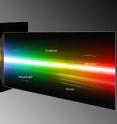VLT captures first direct spectrum of an exoplanet
"The spectrum of a planet is like a fingerprint. It provides key information about the chemical elements in the planet's atmosphere," says Markus Janson, lead author of a paper reporting the new findings. "With this information, we can better understand how the planet formed and, in the future, we might even be able to find tell-tale signs of the presence of life." The researchers obtained the spectrum of a giant exoplanet that orbits the bright, very young star HR 8799. The system is at about 130 light-years from Earth. The star has 1.5 times the mass of the Sun, and hosts a planetary system that resembles a scaled-up model of our own Solar System. Three giant companion planets were detected in 2008 by another team of researchers, with masses between 7 and 10 times that of Jupiter. They are between 20 and 70 times as far from their host star as the Earth is from the Sun; the system also features two belts of smaller objects, similar to our Solar System's asteroid and Kuiper belts.
"Our target was the middle planet of the three, which is roughly ten times more massive than Jupiter and has a temperature of about 800 degrees Celsius," says team member Carolina Bergfors. "After more than five hours of exposure time, we were able to tease out the planet's spectrum from the host star's much brighter light."
This is the first time the spectrum of an exoplanet orbiting a normal, almost Sun-like star has been obtained directly. Previously, the only spectra to be obtained required a space telescope to watch an exoplanet pass directly behind its host star in an "exoplanetary eclipse", and then the spectrum could be extracted by comparing the light of the star before and after. However, this method can only be applied if the orientation of the exoplanet's orbit is exactly right, which is true for only a small fraction of all exoplanetary systems. The present spectrum, on the other hand, was obtained from the ground, using ESO's Very Large Telescope (VLT), in direct observations that do not depend on the orbit's orientation.
As the host star is several thousand times brighter than the planet, this is a remarkable achievement. "It's like trying to see what a candle is made of, by observing it from a distance of two kilometres when it's next to a blindingly bright 300 Watt lamp," says Janson.
The discovery was made possible by the infrared instrument NACO, mounted on the VLT, and relied heavily on the extraordinary capabilities of the instrument's adaptive optics system [3]. Even more precise images and spectra of giant exoplanets are expected both from the next generation instrument SPHERE, to be installed on the VLT in 2011, and from the European Extremely Large Telescope.
The newly collected data show that the atmosphere enclosing the planet is still poorly understood. "The features observed in the spectrum are not compatible with current theoretical models," explains co-author Wolfgang Brandner. "We need to take into account a more detailed description of the atmospheric dust clouds, or accept that the atmosphere has a different chemical composition from that previously assumed."
The astronomers hope to soon get their hands on the fingerprints of the other two giant planets so they can compare, for the first time, the spectra of three planets belonging to the same system. "This will surely shed new light on the processes that lead to the formation of planetary systems like our own," concludes Janson.
Source: ESO
Articles on the same topic
- Caltech astronomer spots second smallest exoplanetWed, 13 Jan 2010, 17:17:12 UTC
Other sources
- Second smallest exoplanet spotted: Discovery highlights new potential for eventually finding Earth-mass planetsfrom Science DailyThu, 14 Jan 2010, 5:28:14 UTC
- Astronomers spot second smallest exoplanetfrom PhysorgWed, 13 Jan 2010, 17:07:17 UTC
- Astronomers capture first direct spectrum of an exoplanetfrom Science DailyWed, 13 Jan 2010, 16:35:15 UTC
- VLT captures first direct spectrum of an exoplanetfrom PhysorgWed, 13 Jan 2010, 16:21:14 UTC
- Light from Faraway Planet Directly Detectedfrom Space.comWed, 13 Jan 2010, 13:35:09 UTC
- How Earth Survived Birth: New Simulation Reveals Planet Migration Prevents Plunge Into Sunfrom PhysorgTue, 12 Jan 2010, 22:42:16 UTC
- Team predicts satellite could locate hundreds of Earth-sized planetsfrom PhysorgTue, 12 Jan 2010, 14:21:10 UTC
- Team predicts satellite could locate hundreds of Earth-sized planetsfrom MIT ResearchTue, 12 Jan 2010, 10:28:08 UTC
- Astronomers spot 'super-Earth' 80 light years awayfrom PhysorgFri, 8 Jan 2010, 21:14:20 UTC
- Earth-like planets could be found soon: astronomersfrom CBC: Technology & ScienceFri, 8 Jan 2010, 14:56:08 UTC
- Astronomers: We could find Earth-like planets soonfrom PhysorgThu, 7 Jan 2010, 23:28:09 UTC
- Astronomers: We could find Earth-like planets soonfrom AP ScienceThu, 7 Jan 2010, 22:28:24 UTC
- How Earth Survived Its Birthfrom Space.comThu, 7 Jan 2010, 19:07:26 UTC
- How the Earth survived birthfrom Science BlogThu, 7 Jan 2010, 17:36:24 UTC
- How Earth survived birth: New simulation reveals planet migration prevents plunge into Sunfrom Science DailyThu, 7 Jan 2010, 17:35:50 UTC
- How the Earth survived birthfrom PhysorgThu, 7 Jan 2010, 17:07:21 UTC
